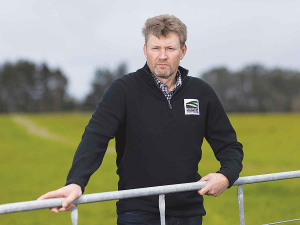It’s a 9m Canadian built Salford 522, imported for Styles by local dealership Paul Wilkins Tractors.
But it’s not just the width that attracted him to it: its weight means it can direct drill into his sometimes hard Waitohi clay and Timaru silt loam soils – no mean feat over such a wide working width.
It also has an aggressive action, Styles having chosen a wider-fluted pre-opener disc than standard, effectively working a 5cm channel of soil for the following disc openers to place seed into at precisely the depth he sets.
Downward pressure on the coulters is adjustable from 18-227kg (90-500lbs) even over the narrowest row spacing of 18cm, which is the option Styles has chosen.
The seed hopper holds about 4.5t of seed wheat, enough for him to drill all day without having to fill up, something he couldn’t do with most New Zealand made drills, even though they have much narrower working widths, he notes.
Price was another factor in the Salford’s favour. “It was relatively sharp for the amount of machine you get compared to a New Zealand built drill,” he comments.
He’s not planning to do any contracting with the machine, so how does he justify such a massive tool on a property of 400ha, of which about 300ha is cropped?
“It’s a good question but I believe in horsepower. You can spend an extra $50,000/year on extra horsepower and machinery if you don’t employ someone and for me that’s better than money spent on a man. Horsepower gets the work done quickly and easily, and it keeps things simple.”
The drill has replaced a 3m (10 ft) triple disc Duncan Enviro which he also used as a direct drill. That had the option of putting fertiliser ‘down the spout’ with seed, which is also an option on the Salford, but it wasn’t something he was routinely doing with the old drill anyway.
“I’ve been applying fertiliser ahead of the drill for more than ten years and been happy with the results, so why change?”
Paul Wilkins, who imported and assembled the drill for Styles, notes most wide drills on the New Zealand market are 8m, and not nearly as heavily built.
“This is an altogether bigger structure. I’ve not seen any others up on tractor-size wheels like this one, and it’s only a mid-size model in their range!”
Styles says the big wheels mean a larger footprint, hence lower ground pressure and smoother ride which is good for control of seeding depth and reduced wear on the sturdy axles.
“The stub axle isn’t going to break off, which wouldn’t be the case with many drills. They’re just not built to handle the conditions.”
Currently he is pulling the Salford with a 1980s John Deere 8440. While it looks a big tractor, it is only 215hp and with 15,000 hours on the clock it is struggling on some of the steeper hills.
“I knew the old girl was going to be at her limits pulling this drill. A new, larger tractor is part of the long term plan.”
With the 8840 he’s been travelling at 8-9 km/h with the drill, a comfortable speed for triple-disc type drills. Seed depth and spacing have proven excellent as has accuracy of the Salford designed metering unit.
“Calibrate it for your seed rate, and that’s what it delivers.”
At 8-9km/h he was covering 8ha/hr so while it was frustrating not being able to get on after it turned wet in early April this year – “with direct drilling you’ve got to have the ground in the right condition” – he’s looking forward to knocking off the remaining area to sow soon.
“It’s going to make the spring work a lot easier and we should get through it relatively quickly.”

















